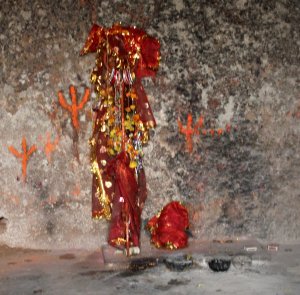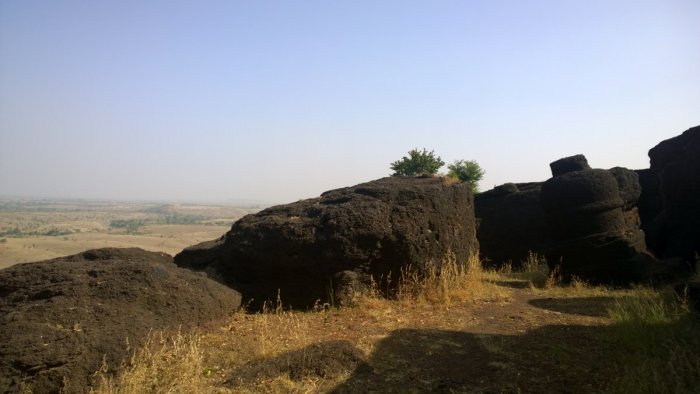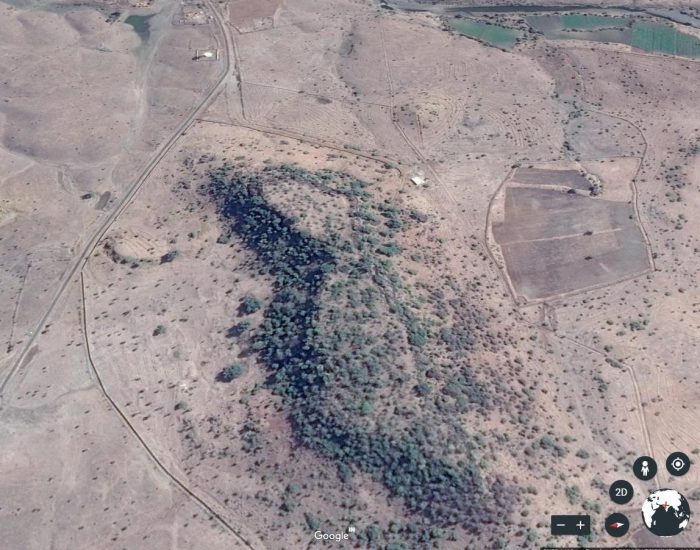It is a little after 10 am on a November morning in 2016 when we arrive at the base of the hillock that houses the Kolvi Caves, one of the three Buddhist rock-cut cave sites in Rajasthan. A board displaying some rather sketchy information about the caves reassure us that we are in the right place.
It says that the Kolvi Caves was a monastic complex of about 50 rock-cut caves, most of which have collapsed today and details have disappeared due to natural weathering. The presence of a big rock-cut stupa in the shape of a structural stupa, as we know it today, is considered to be an important and notable feature of the Kolvi Caves. It has been suggested that the absence of Bodhisattva figures at the site indicates that this was a site of Buddhist monks of the Hinayana (or Theravada) sect. The board doesn’t mention an important detail — the age of the Caves.
Apart from my friend Niti, our car driver and me, there is no one else around at the site. I take a minute to appreciate the surroundings and the location. The blackish red Kolvi hillock, which is entirely composed of laterite, rises quite suddenly and dramatically from a flat landscape.
A flight of steps, probably built over a pre-existing path, leads to the top of the hill where the Caves are located. A short climb later, Niti and I are opening the gate that leads into the cave complex.

We step into a small clearing which has cement seats arranged outside some of the ‘caves. One of the first things I notice is that all the caves are numbered in white paint; while this is really helpful, I just wish it could have been aesthetically done. A quick look reveals that most of the caves are rather small single storied structures, though a couple of them are double-storied. While most of the caves are empty, some of them have seated figures in a meditative pose. While available literature says that these are sculptural reliefs of the Buddha, seeing the featureless sculptures brings on a touch of the disbelief.
 While nobody lives in these caves now, there are tell-tale signs of some of them being used for worship. Cave 2, which houses one of the relief sculptures of the Buddha, had offerings of coconut and incense placed at its feet.
While nobody lives in these caves now, there are tell-tale signs of some of them being used for worship. Cave 2, which houses one of the relief sculptures of the Buddha, had offerings of coconut and incense placed at its feet.
Another cave had been ‘converted’ into a Hindu place of worship (see photo on the left) with a stone smeared with saffron, marks of the trishul or trident on the walls and a saree-clad figure, representing the goddess. This one had unlit oil lamps and some pieces of coconut as offerings before it.
There is a rough path that one can follow to explore all the caves, but I found it easier to follow the cave numbers for it ensured that I didn’t miss a single cave. The looping path made me go around in circles a couple of times, before I realised what was happening.
It was a relief to find that the Kolvi caves did not have the inhabitants that most abandoned structures and ruins usually do — bats ! Instead, there were hundreds of dragon flies flitting in and out of the caves and the vegetation growing there. It was a beautiful sight and it was their slight humming sound that made me aware of the silence around me.
A silence that was not of the pin drop or deafening variety, but one that made me keenly aware of everything around me — the sound of the soft breeze rustling through the grass, the absence of sounds from vehicular traffic, birdsong, my footsteps, and also realising that Niti and I had got separated somewhere along the way… Even though I knew that Niti was somewhere close by and our car driver was waiting at the foot of the hillock, at that moment I felt like I was the only human being around. It was a strange feeling of being keenly aware of my surroundings and of literally being aware of every inhalation and exhalation. Quite indescribable too !

And then quite suddenly, the spell was broken as Niti came into view and we decided to tour the caves once again, but together, before we left. (Later on, when I narrated to Niti my experience of the silence and of being alone, I was surprised to find that she too had experienced something similar. Maybe it was the place, we both concluded.)
Ready to see pictures from the Kolvi Caves? Click on any of the photographs below will start a slide show and you can use the arrow keys to navigate through the set. Once you have finished, do come back to read the rest of the post.
Back home after the trip and in the months leading to this blog post, I have been thinking a lot about Kolvi and the monastic community that once inhabited it. The lack of reliable information has also been quite frustrating. Let me post some of the questions that I have about the caves and my suggested answers. But do note, that I am no expert and while I could be right, I could also be completely wrong or my guesses could fall somewhere in between the two.
Before we get into the questions, see a screenshot of the Kolvi Caves that I took from Google Earth. It will give you an idea of what the location is like and how the caves are arranged on the hill-top.

Why were the caves built here? Why Kolvi? The Buddhist built their monasteries near major roads so as not to be completely isolated. The hillocks were perfect for privacy, but were not too far away from civilisation either. The road near which the Kolvi Caves are located was an ancient trade route, now a state highway. There caves are one of the three in the area — the others being Binayagga and Hathya Gaur (which I was unfortunately not able to visit :(). There is another set of Buddhist caves at Dhamnar across the border in Madhya Pradesh, about 100 km away. It is quite possible that Buddhism was thriving in the region and the monks were welcomed by the villagers to set up their monasteries. Whether these four monasteries belonged to the same sect is an open question for which I will reserve comment as I haven’t seen the other caves.
How old are the Kolvi Caves? I honestly don’t know, and I wouldn’t even want to guess for I have absolutely no idea about how one goes dating the caves using stylistic references. And the lack of information or discussion surrounding the caves is so frustrating.
What was the monastic community like? I don’t know, but I would like to think that they were a rather solitary bunch who spent a lot of time in prayer, going by the number of shrines in such a small area.
Who built these caves? Was each cave built through individual donations or was a certain amount collected and then the caves built? I wish I knew. There are absolutely no records or inscriptions that have been found; perhaps the centuries of weathering have obliterated them.
However, the question that I have been most interested in and something that concerns the geology of the area rather than the Kolvi Caves itself is the laterite that the caves have been carved out of. The Kolvi Caves are unusual in the sense that they are perhaps the only set of Caves (along with the nearby ones at Binnayagga and Hathya Gaur) to have been carved out of laterite. Now, laterite requires an extremely wet and humid climate to form (much like the Goa and Karnataka coasts where they are found in abundance) and Rajasthan’s dry climate if far from that. The laterite at Kolvi suggest a paleoclimate in the distant geological past of tropical conditions in the area that resulted in the formation of laterite.
Interesting and exciting, isn’t it? Both the geology of the caves and the caves itself, that is. 🙂
PS: If you know something about these caves or the geology or both, please do share it here in the comments section. Thank you.
Acknowledgements: A big thank you to Arjun a.k.a @Hidden Heritage for telling me about Kolvi. If not for him, I wouldn’t have known of their existence and therefore, missed a chance at visiting them.
The Hadoti Trip Series: Dear Hadoti | Discovering Jhalawar | The painted rooms in Garh Mahal of Jhalawar | Bhawani Natyashala: The Opera House of Jhalawar | An evening in Jhalrapatan | The Buddhist rock-cut caves at Kolvi | The Gagron Fort at Jhalawar |An impact crater, a temple ruin and some discoveries | A fun evening in Kota | A safari on the River Chambal | The painted rooms of Kota Garh | The Shiva temples of Bijolia | The temples at Badoli | That and this in Bundi | The painted rooms of Bundi Palace | The stepwells of Bundi | The Hadoti Trip Planner |
Join me on Twitter, Facebook and Instagram as I explore the world around me and share “My Favourite Things” with you.















So interesting!!! The photos are excellent and provide great insight into the culture there!
LikeLiked by 1 person
Welcome here, RyanC. Thank you so much for stopping by and commenting here. Very happy that you liked the post and the accompanying photographs. Cheers !
LikeLike
What a gem of a find… not only your blog but also these caves! I had no idea they existed! How rich India is!
Your photos are absolutely stunning! Also loved the illuminating captions. Thank you!
LikeLiked by 1 person
Hello Dagny. A very warm welcome to “My Favourite Things” and thank you so much for stopping by and commenting your appreciation.
I wasn’t aware of the Kolvi Caves or the other two Buddhist Caves before to trip either, and they were a serendipitous discovery. That’s what I love the most about travel – the sudden discoveries and the happiness they bring.
Hope you’ll keep visiting.
LikeLiked by 1 person
Indeed travel affords fabulous opportunities for delightful discoveries. You see things whose beauty takes you out of yourself. You wonder how the treasures have remained undiscovered by the majority of humanity. In a way you feel sorry for all those who have not had the chance to experience those places- and grateful that you have had the chance.
LikeLiked by 1 person
I would guess – and just guess – that these are much older than most of the better known sites. As Buddhism and its adherents fanned out from its known place of origin, Kolvi must have been along the the major routes. But we cannot be sure without evidence
LikeLiked by 1 person
Kolvi would have been along or close to a major trade route, like most other Buddhist monasteries. However, I’m no expert in dating it and would leave it to those who can.
LikeLike
“While available literature says that these are sculptural reliefs of the Buddha, seeing the featureless sculptures brings on a touch of the disbelief.”
For invaders and/or believers of faiths other than Buddhism, reducing the Buddha statues/statuettes to dust thoroughly would take too much time. In order to reduce these statues from the level of gods to the puny pieces of carved stone that the disbelievers thought they were, they would chisel off the faces and any other recognizable marks these statues had. Once that happened, believers did not have a god to pray to and would be more susceptible to other faiths.
Which is why the sculptures you saw are featureless now, and if you go to museums you will see stone sculptures with parts of their art chiseled off – exactly at the locations where the faces of the gods should be.
LikeLiked by 1 person
When I said “…touch of the disbelief”, I meant just how badly weathered the reliefs are. The ones at Kolvi have not suffered any deliberate damage, at least none that I could see. They have just weathered away over centuries. Laterites can suffer this kind of extensive weathering, so in that sense I’m not surprised.
LikeLike
Very interesting Sudha. The caves remind me of Kanheri, and like them, might even have been built over a period of time. The figures of the Buddhas/ Bodhisattvas appear extremely weathered, probably because of the laterite?
LikeLiked by 1 person
As I mentioned in an earlier comment, I’m not going to speculate on the age as I just don’t know enough. The current condition of the caves is such that I can’t even suggest if they were built over a long period or short. So I’m going to keep quiet here as well.
Laterites weather extremely quicjkly especially in the wet/dry weather that the area has.
PS: I must go back to Kanheri again.
LikeLike
Glad to know about this place.
LikeLiked by 1 person
Thank you, Niranjan. Hope you visit this place sometime. 🙂
LikeLike